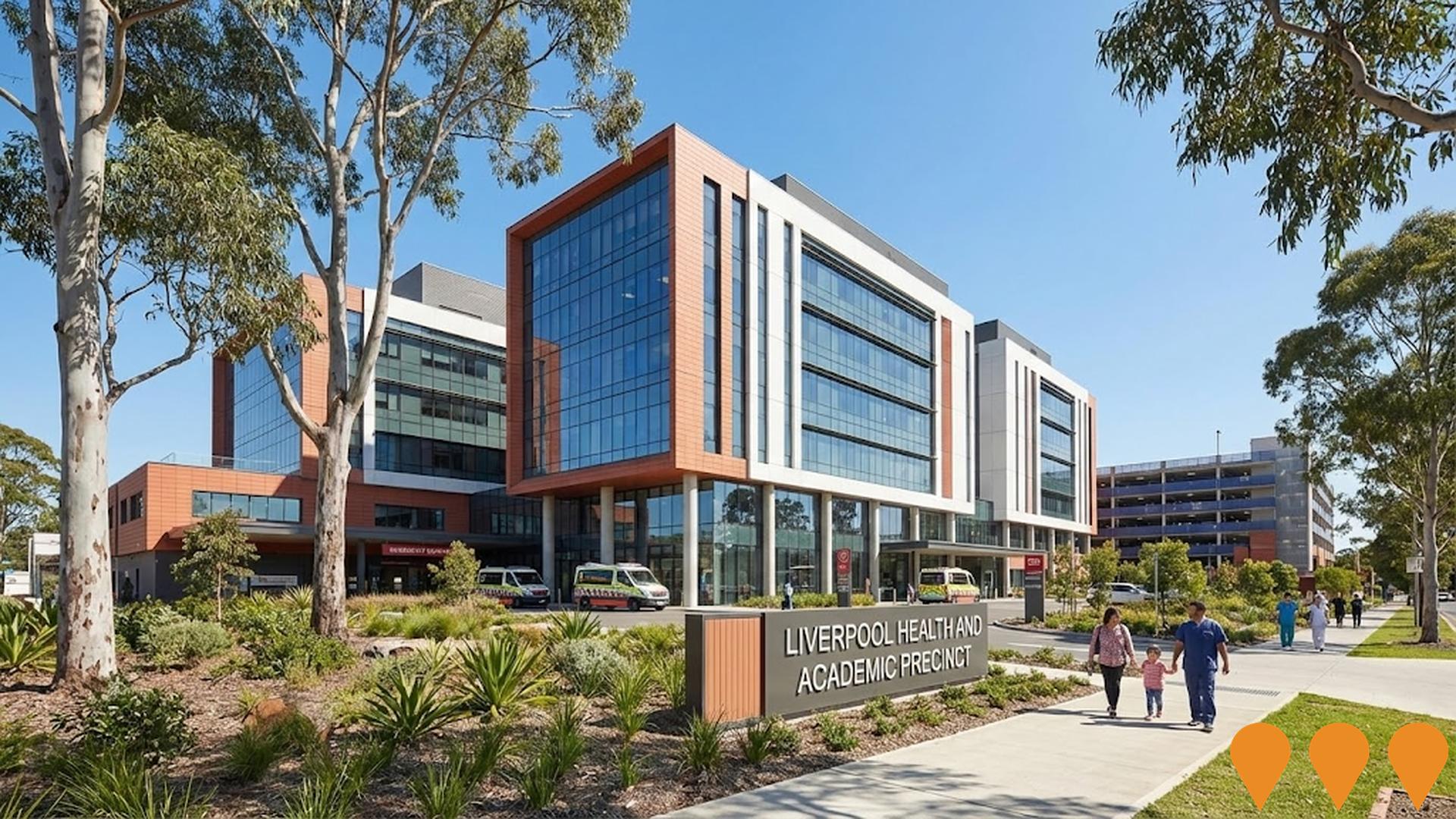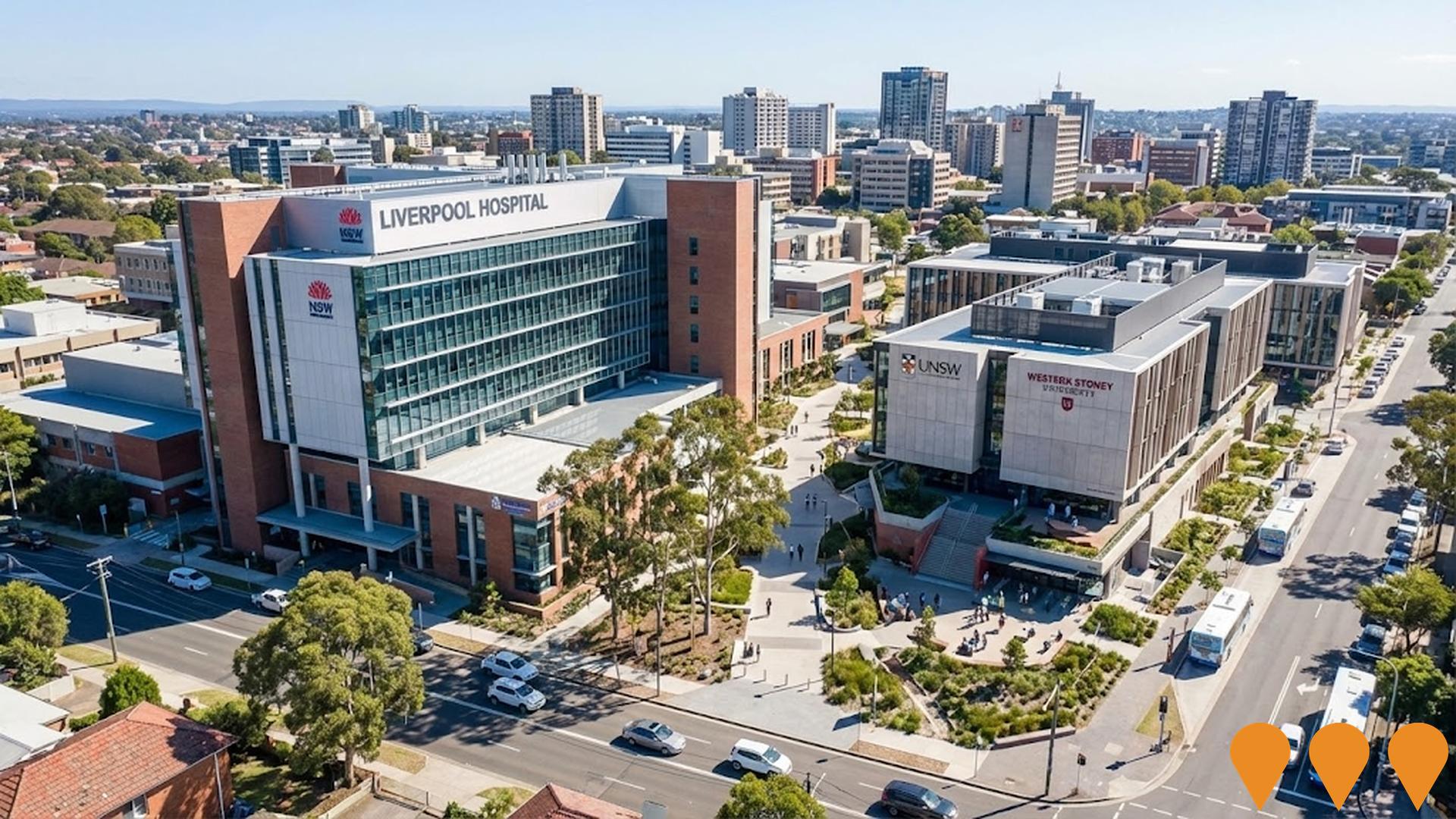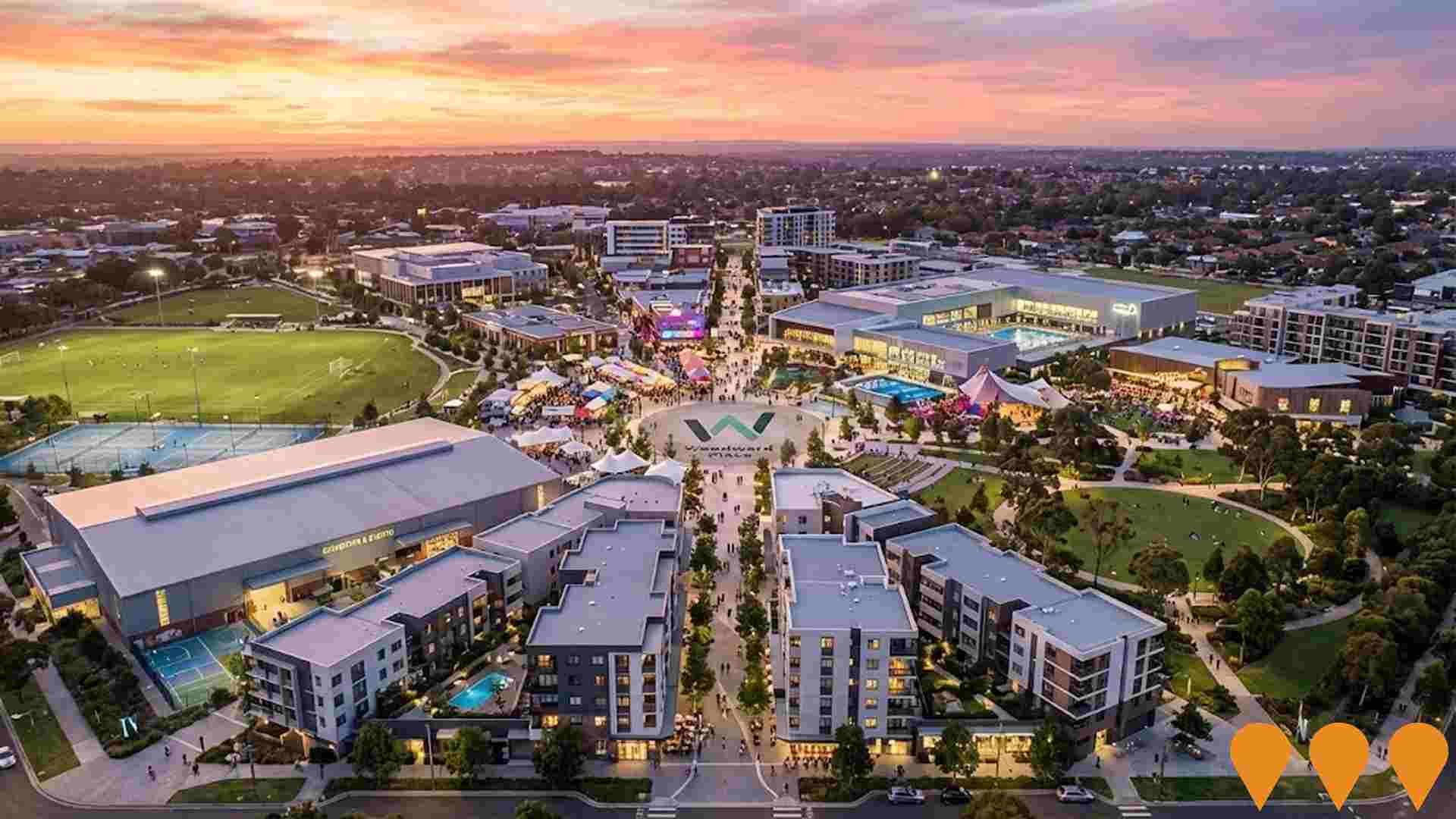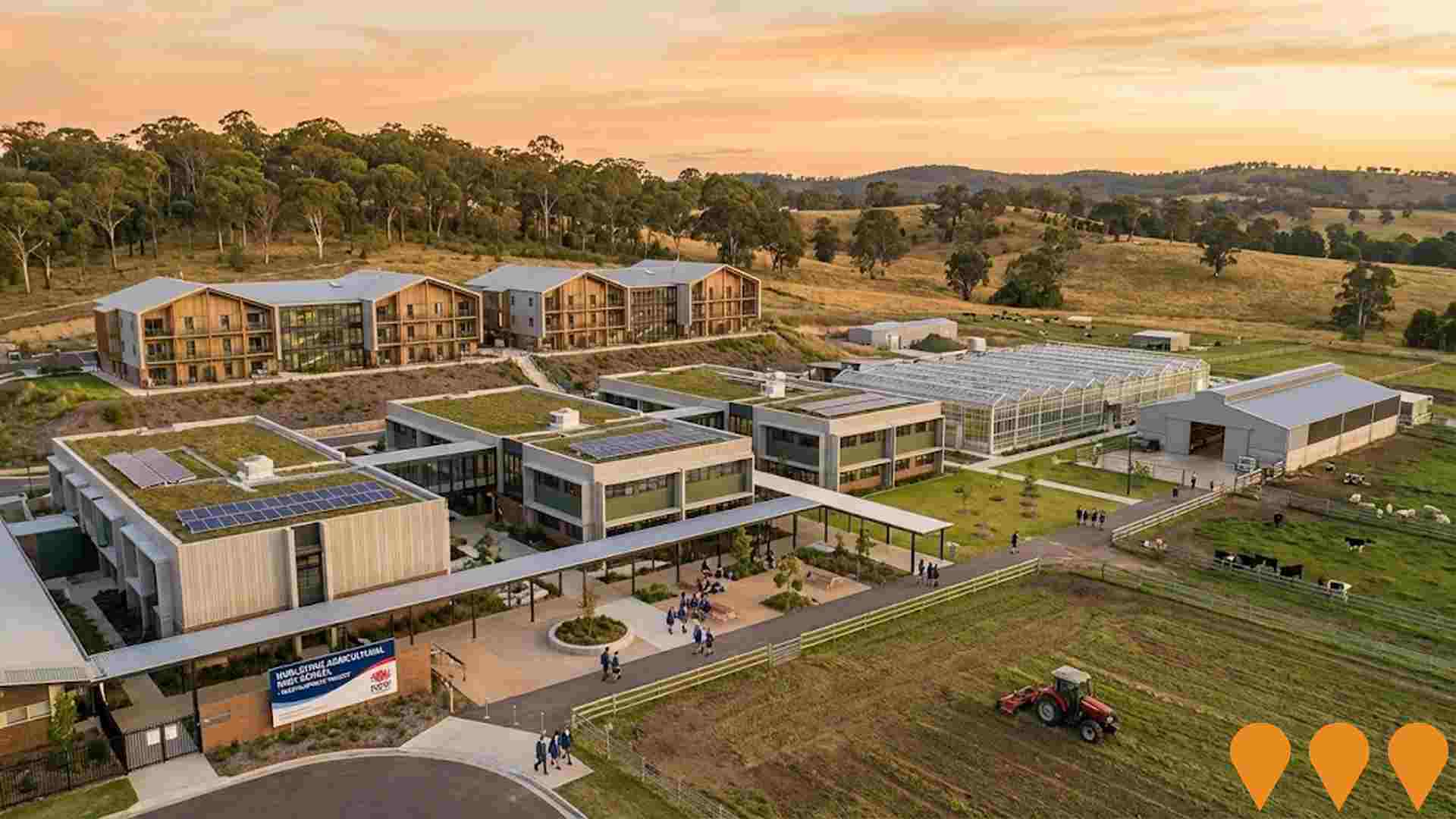Chart Color Schemes
est. as @ -- *
ABS ERP | -- people | --
2021 Census | -- people
Sales Activity
Curious about local property values? Filter the chart to assess the volume and appreciation (including resales) trends and regional comparisons, or scroll to the map below view this information at an individual property level.
Find a Recent Sale
Sales Detail
Population
Population growth drivers in Liverpool - West are strong compared to national averages based on AreaSearch's ranking of recent, and medium to long-term trends
Liverpool - West's population is approximately 14,897 as of August 2025. This figure represents an increase of 1,160 people, or 8.4%, since the 2021 Census, which reported a population of 13,737. The change is inferred from the estimated resident population of 14,895 in June 2024 and an additional 356 validated new addresses since the Census date. This results in a population density ratio of 3,669 persons per square kilometer, placing Liverpool - West in the upper quartile relative to national locations assessed by AreaSearch. The area's growth rate of 8.4% since the 2021 census exceeds both the state (6.4%) and metropolitan area rates, indicating its status as a growth leader in the region. Overseas migration contributed approximately 76.4% of overall population gains during recent periods.
AreaSearch is using ABS/Geoscience Australia projections for each SA2 area, released in 2024 with 2022 as the base year. For areas not covered by this data, AreaSearch employs NSW State Government's SA2 level projections, released in 2022 with 2021 as the base year. Growth rates by age group from these aggregations are applied to all areas for years 2032 to 2041. Based on projected demographic shifts, Liverpool - West is forecasted to experience a significant population increase in the top quartile of Australian statistical areas. By 2041, the area's population is expected to grow by 3,638 persons, representing a total gain of 24.3% over the 17-year period.
Frequently Asked Questions - Population
Development
AreaSearch assessment of residential development activity positions Liverpool - West among the top 25% of areas assessed nationwide
Liverpool - West has seen approximately 84 new homes approved annually. Over the past five financial years, from FY21 to FY25, around 422 homes were approved, with an additional 10 approved so far in FY26. On average, about two new residents have arrived per year for each new home over these five years, indicating a balanced supply and demand dynamic. However, this has accelerated recently, with approximately 5.5 people moving into each dwelling over the past two financial years, suggesting increasing demand and tightening supply.
New homes are being constructed at an average expected cost of $283,000, which is below the regional average, potentially offering more affordable housing options for buyers. In FY26, around $200,000 in commercial approvals have been registered, indicating limited commercial development activity compared to residential growth. Relative to Greater Sydney, Liverpool - West has about three-quarters the building activity per person but ranks among the 80th percentile nationally. Recent periods show increased development activity. The current new building activity comprises approximately 32% detached houses and 68% townhouses or apartments, marking a significant shift from existing housing patterns (currently 54% houses), potentially due to diminishing developable land availability and evolving lifestyle preferences.
With around 144 people per dwelling approval, Liverpool - West exhibits characteristics of a growth area. Future projections indicate that Liverpool - West will add approximately 3,624 residents by 2041. Current construction rates appear balanced with future demand, fostering steady market conditions without excessive price pressure.
Frequently Asked Questions - Development
Infrastructure
Liverpool - West has very high levels of nearby infrastructure activity, ranking in the top 20% nationally
Changes to local infrastructure significantly impact an area's performance. AreaSearch identified 31 projects likely affecting the region. Notable initiatives include Frangipane Avenue Apartments, Liverpool Civic Place, 28 Residential Attached Dwellings, and Liverpool Health and Academic Precinct. The following list details those most relevant.
Professional plan users can use the search below to filter and access additional projects.
INFRASTRUCTURE SEARCH
 Denotes AI-based impression for illustrative purposes only, not to be taken as definitive under any circumstances. Please follow links and conduct other investigations from the project's source for actual imagery. Developers and project owners wishing us to use original imagery please Contact Us and we will do so.
Denotes AI-based impression for illustrative purposes only, not to be taken as definitive under any circumstances. Please follow links and conduct other investigations from the project's source for actual imagery. Developers and project owners wishing us to use original imagery please Contact Us and we will do so.
Frequently Asked Questions - Infrastructure
Liverpool Civic Place
790 million mixed-use civic and commercial precinct in Liverpool CBD. Stage 1 (civic hub including new Council chambers, library, TAFE NSW, childcare, plaza and 450-space car park) completed and opened December 2023. Stage 2 (two towers: one civic/commercial/university building and one build-to-rent residential tower with 320 apartments) is under construction with practical completion expected mid-2027.

Liverpool Health and Academic Precinct
The $830 million Liverpool Health and Academic Precinct (LHAP) is a major redevelopment of Liverpool Hospital creating an international hub for clinical innovation, medical research, and education in South Western Sydney. Phase 1 delivered a new five-storey Integrated Services Building (completed October 2024) with expanded Emergency Department, neonatal intensive care unit, birthing suites, maternity and children's services, pathology, and ambulatory care. Phase 2 (underway, completion 2027) includes a new multi-storey Integrated Services Building with inpatient units, integrated cancer centre featuring the ACRF Oasis Wellness Centre, expanded women's and children's services, additional inpatient beds, research facilities, and supporting infrastructure. The precinct serves one of NSW's fastest-growing regions and includes prior multi-storey car park (2022).

Liverpool Innovation Precinct
A health, education, and research innovation precinct anchored by the ongoing $790 million Liverpool Hospital redevelopment. The precinct is a collaboration focused on health technologies, cancer care, translational research, and robotics, supported by a multi-university education hub (UNSW, Western Sydney University) and city centre public domain upgrades to create a vibrant economic hub.

Liverpool City Centre Renewal - Sydney's Third CBD
Ongoing strategic renewal of Liverpool City Centre as Sydney's Third CBD. The 2018 rezoning (LLEP Amendment 52) enables high-density mixed-use development across approximately 25 hectares. Multiple private and public projects are now in planning, development application or construction stages, guided by the Liverpool Collaboration Area Place Strategy (2023) and Liverpool Local Strategic Planning Statement. Focus on residential, commercial, retail, civic and public domain upgrades to support population and job growth to 2036 and beyond.

Woodward Place Masterplan
A 30-year masterplan to transform the 28-hectare Woodward Park site in Liverpool into a major lifestyle, cultural, recreational and community precinct, including new sports facilities, cultural venues, public spaces and potential future residential and mixed-use development to support Liverpool's growing population.

Hurlstone Agricultural High School Redevelopment
Major redevelopment by School Infrastructure NSW including two new student accommodation buildings, upgraded learning facilities, modernized agricultural teaching spaces, and enhanced residential facilities for this selective agricultural school.

Light Horse Park Redevelopment
Council-led multi-stage redevelopment of Light Horse Park into a vibrant, inclusive riverfront destination. Stage 1 (accessible kayak launch) complete. Current works (Stage 2) include carpark upgrades, lighting, CCTV, landscaping and EV infrastructure (expected completion April 2026). Future stages include enhanced play spaces, fitness stations, riverbank restoration, viewing platforms, pavilions, picnic areas, oval upgrades and a new community hub. Total project value approximately $36.7 million, funded by NSW Government (WestInvest/WSIG) in association with Liverpool City Council. Expected overall completion early 2027.

Liverpool West Public School Upgrade
NSW Department of Education, via School Infrastructure NSW, delivered a two-stage upgrade of Liverpool West Public School to increase capacity and modernize facilities. Stage 1 (handed over early 2023) delivered 16 flexible learning spaces, 4 special programs rooms, a new hall with COLA, and a new library. Stage 2 facilities were scheduled for Day 1, Term 1, 2024 and included 28 additional flexible learning spaces, 4 support rooms, and a refurbished Mainsbridge House with 2 preschool rooms for Coota Gulla Preschool. Works substantially completed by early 2024.

Employment
AreaSearch assessment indicates Liverpool - West faces employment challenges relative to the majority of Australian markets
Liverpool - West has an unemployment rate of 9.3% as of June 2025, with estimated employment growth of 6.0% over the past year. There are 5,380 residents in work, and the unemployment rate is 5.1%, which is higher than Greater Sydney's rate of 4.2%.
Workforce participation stands at 38.6%, significantly lower than Greater Sydney's 60.0%. Employment is concentrated in health care & social assistance, retail trade, and manufacturing, with a strong specialization in manufacturing (1.7 times the regional level). However, professional & technical services are under-represented, with only 4.7% of Liverpool - West's workforce compared to Greater Sydney's 11.5%. Over the year to June 2025, employment increased by 6.0%, while labour force grew by 4.9%, reducing the unemployment rate by 1.0 percentage points.
In contrast, Greater Sydney saw employment grow by 2.6% and unemployment rise slightly. National employment forecasts from Jobs and Skills Australia (May 2025) project national growth of 6.6% over five years and 13.7% over ten years. Applying these projections to Liverpool - West's employment mix suggests local growth of approximately 6.3% over five years and 13.3% over ten years.
Frequently Asked Questions - Employment
Income
Income metrics place the area in the bottom 10% of locations nationally according to AreaSearch analysis
AreaSearch's latest postcode level ATO data for financial year 2022 shows income in Liverpool - West is lower than average nationally. The median income is $34,480 and the average is $40,538. In comparison, Greater Sydney has a median income of $56,994 and an average of $80,856. Based on Wage Price Index growth of 12.61% since financial year 2022, estimated incomes as of September 2025 would be approximately $38,828 (median) and $45,650 (average). The 2021 Census indicates that household, family, and personal incomes in Liverpool - West fall between the 3rd and 16th percentiles nationally. The earnings profile shows that 28.7% of locals (4,275 people) earn between $1,500 and $2,999 annually, reflecting a regional pattern where 30.9% also fall within this range. Housing affordability pressures are severe in the area, with only 77.4% of income remaining after housing costs, ranking at the 11th percentile nationally.
Frequently Asked Questions - Income
Housing
Liverpool - West displays a diverse mix of dwelling types, with above-average rates of outright home ownership
In Liverpool - West, as evaluated at the latest Census in 2016, dwelling structures consisted of 53.9% houses and 46.1% other dwellings including semi-detached homes, apartments, and 'other' dwellings. This compares to Sydney metro's structure which was 63.3% houses and 36.8% other dwellings. Home ownership in Liverpool - West stood at 25.1%, with mortgaged dwellings at 24.0% and rented dwellings at 50.9%. The median monthly mortgage repayment in the area was $1,733 as of June 2018, below Sydney metro's average of $2,167, while the median weekly rent figure was $360 compared to Sydney metro's $400. Nationally, Liverpool - West's mortgage repayments were lower than the Australian average of $1,863, and rents were less than the national figure of $375 as of June 2018.
Frequently Asked Questions - Housing
Household Composition
Liverpool - West has a typical household mix, with a lower-than-average median household size
Family households constitute 73.3% of all households, including 36.9% couples with children, 17.0% couples without children, and 17.7% single parent families. Non-family households account for the remaining 26.7%, with lone person households at 24.2% and group households comprising 2.5%. The median household size is 2.9 people, which is smaller than the Greater Sydney average of 3.0.
Frequently Asked Questions - Households
Local Schools & Education
Educational outcomes in Liverpool - West fall within the lower quartile nationally, indicating opportunities for improvement in qualification attainment
The area's university qualification rate is 19.2%, significantly lower than Greater Sydney's average of 38.0%. Bachelor degrees are the most common at 13.8%, followed by postgraduate qualifications (4.4%) and graduate diplomas (1.0%). Vocational credentials are prevalent, with 29.7% of residents aged 15+ holding them - advanced diplomas at 11.4% and certificates at 18.3%. Educational participation is high, with 34.1% of residents currently enrolled in formal education: 11.4% in primary, 8.7% in secondary, and 5.6% in tertiary education.
Liverpool - West has 3 schools with a combined enrollment of 1,542 students. The area has varied educational conditions, including 2 primary and 1 K-12 school. School places per 100 residents are lower than the regional average (10.3 vs. 16.7), indicating some students may attend schools in nearby areas.
Frequently Asked Questions - Education
Schools Detail
Nearby Services & Amenities
Transport
Transport servicing is high compared to other areas nationally based on assessment of service frequency, route connectivity and accessibility
Liverpool-West has 89 active public transport stops, all of which are bus stops. These stops are served by 63 different routes that together facilitate 4,976 weekly passenger trips. The area's transport accessibility is rated as excellent, with residents on average located just 122 meters from the nearest stop.
Buses run an average of 710 trips per day across all routes, which amounts to approximately 55 weekly trips per individual stop.
Frequently Asked Questions - Transport
Transport Stops Detail
Health
Liverpool - West's residents are healthier than average in comparison to broader Australia with prevalence of common health conditions quite low among the general population though higher than the nation's average across older, at risk cohorts
Liverpool - West residents have a relatively positive health profile, with low prevalence of common health conditions among the general population compared to national averages. However, certain cohorts such as older adults and those at risk have higher prevalence rates. As of 2021, approximately 46% (~6,778 people) of the total population has private health cover, lower than Greater Sydney's 50.4% and the national average of 55.3%.
The most prevalent medical conditions are arthritis (7.0%) and diabetes (6.4%), while 72.9% of residents report no medical ailments, compared to 76.4% in Greater Sydney. The area has a higher proportion of seniors aged 65 and over at 16.6% (2,471 people), compared to 12.8% in Greater Sydney. Health outcomes among seniors require more attention due to presenting challenges.
Frequently Asked Questions - Health
Cultural Diversity
Liverpool - West is among the most culturally diverse areas in the country based on AreaSearch assessment of a range of language and cultural background related metrics
Liverpool-West has a population where 59.3% were born overseas, with 71.3% speaking languages other than English at home. Christianity is the predominant religion in Liverpool-West, accounting for 45.1%. The 'Other' religious category comprises 16.1%, significantly higher than Greater Sydney's average of 5.1%.
Ancestry-wise, the top groups are Other (37%), Australian (10.5%), and English (8.6%). Notably, Serbian ancestry is overrepresented at 6.3% compared to the regional average of 2.4%, as are Vietnamese (5.6% vs 3.6%) and Lebanese (4.4% vs 5.2%).
Frequently Asked Questions - Diversity
Age
Liverpool - West's population is slightly younger than the national pattern
Liverpool-West's median age is nearly matching Greater Sydney's average of 37 years, which is modestly under the Australian median of 38 years. Relative to Greater Sydney, Liverpool-West has a higher concentration of residents aged 0-4 (7.0%) but fewer residents aged 35-44 (13.1%). Between the 2021 Census and now, the population aged 15-24 has grown from 13.0% to 13.7%. Conversely, the population aged 45-54 has declined from 11.6% to 10.6%. By 2041, demographic modeling suggests Liverpool-West's age profile will evolve significantly. The 45-54 cohort is projected to grow by 73%, adding 1,159 residents to reach a total of 2,740. In contrast, both the 25-34 and 15-24 age groups are expected to see reduced numbers.

